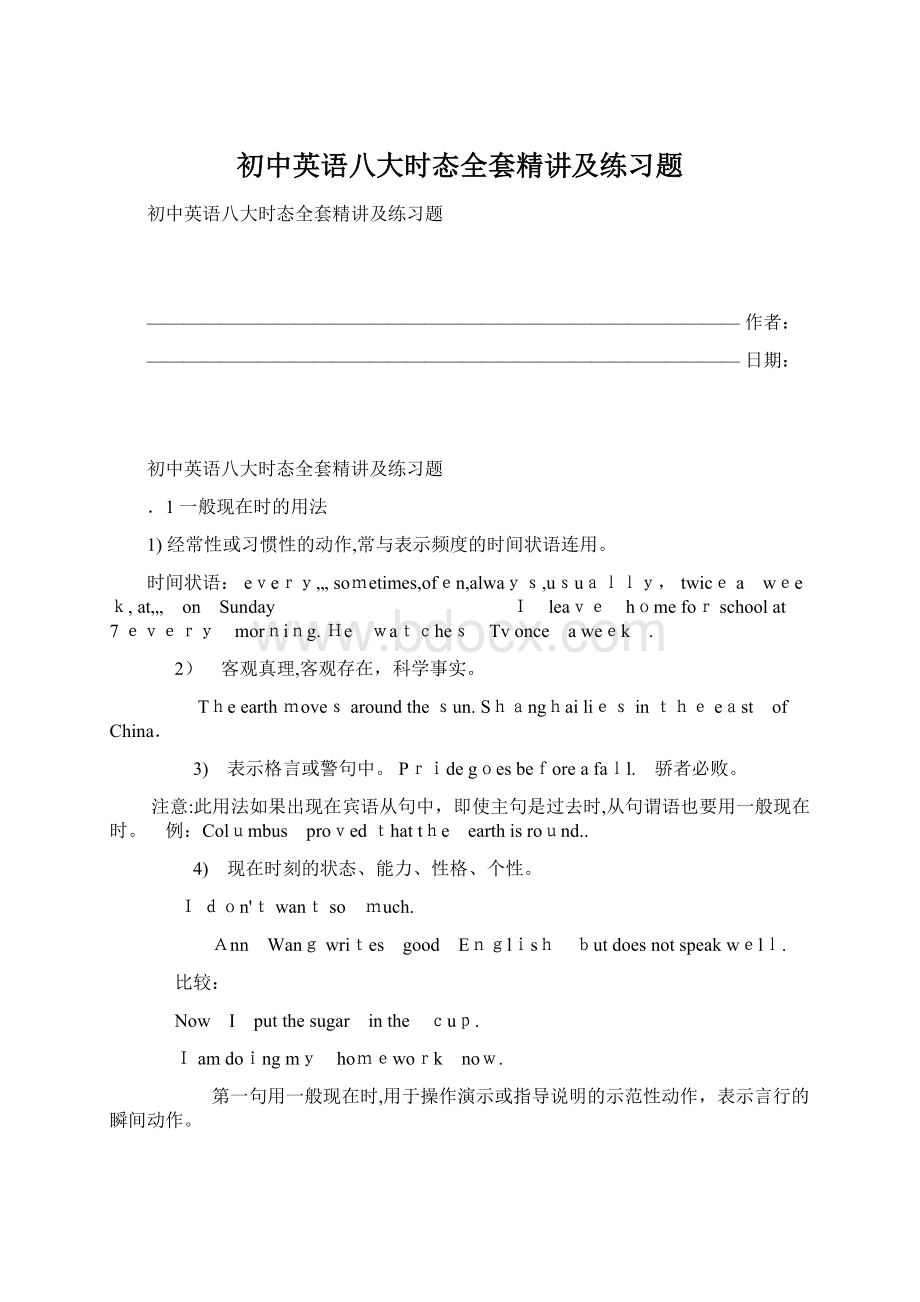初中英语八大时态全套精讲及练习题.docx
《初中英语八大时态全套精讲及练习题.docx》由会员分享,可在线阅读,更多相关《初中英语八大时态全套精讲及练习题.docx(27页珍藏版)》请在冰豆网上搜索。

初中英语八大时态全套精讲及练习题
初中英语八大时态全套精讲及练习题
————————————————————————————————作者:
————————————————————————————————日期:
初中英语八大时态全套精讲及练习题
.1一般现在时的用法
1)经常性或习惯性的动作,常与表示频度的时间状语连用。
时间状语:
every„,sometimes,ofen,always,usually,twicea week,at„, on Sunday I leave homeforschoolat 7every morning.He watches Tvonce aweek .
2) 客观真理,客观存在,科学事实。
Theearthmovesaroundthesun.Shanghailiesintheeast of China.
3) 表示格言或警句中。
Pridegoesbeforeafall. 骄者必败。
注意:
此用法如果出现在宾语从句中,即使主句是过去时,从句谓语也要用一般现在时。
例:
Columbus provedthatthe earthisround..
4) 现在时刻的状态、能力、性格、个性。
Idon'twantso much.
Ann Wangwrites good English butdoesnotspeakwell.
比较:
Now I putthesugar inthe cup.
Iamdoingmy homework now.
第一句用一般现在时,用于操作演示或指导说明的示范性动作,表示言行的瞬间动作。
再如:
Nowwatchme,Iswitchon thecurrentandstandback.
第二句中的now是进行时的标志,表示正在进行的动作的客观状况,所以后句用一般现在时。
二.构成及变化
1、be动词的变化
肯定句:
主语+be(am,is,are)+其它。
如:
Iamaboy.我是一个男孩。
否定句:
主语+be+ not +其它。
如:
Heis notaworker.他不是工人。
一般疑问句:
Be+主语+其它。
如:
-Areyouastudent?
-Yes.Iam./ No,I'mnot.
特殊疑问句:
疑问词+一般疑问句。
如:
Whereismy bike?
2、行为动词的变化当主语为第一,二人称及复数时,助动词为do
肯定句:
主语+动词原形(+其它)。
如:
Weoftenplaybasketballafterschool.
否定句:
主语+ don't+动词原形(+其它)。
如:
we don’tplaybasketballafterschool.
一般疑问句:
Do+主语+动词原形+其它?
如:
Doyou oftenplaybasketballafter schooll?
Yes, wedo./ No,wedon't.
特殊疑问句:
疑问词+以do开头的一般疑问句?
如:
Whatdoyouoftendoafterschool?
当主语为第三人称单数时,助动词为does
肯定句:
主语+动词三单式(+其它)。
如:
Heswimswell.
否定句:
主语+doesn’’’t+动词原形(+其它)。
如:
He doesn’tswimwell.
一般疑问句:
Does+主语+动词原形+其它如:
Doeshe swimwell?
Yes, hedoes. /No,hedoesn't.
特殊疑问句:
疑问词+以does开头的一般疑问句?
如:
How doesyour fathergotowork?
三、第三人称单数的动词变化规则(只有在第三人称为主语的肯定句中,动词才用三单式)
(1)多数动词直接加s:
runsgets likescolletstakes playsclimbs„„.
(2)结尾是s, x,sh, ch,o,前为辅音字母,结尾加es:
watches teachesgoesdoeswashescrossesmixesbrushes
(3)动词末尾y前为辅音:
将y改为i加es:
study→studiesfly→fliescarry→carriescry→cries
但在y前如果为元音则直接加s:
buys says
2一般过去时的用法
1)在确定的过去时间里所发生的动作或存在的状态。
时间状语有:
yesterday,an hourago, theother day,in1982yesterdaymorning(afternoon,evening„) last night (week,month,year„),a momentago,aweekago,three yearsago„ justnow,等。
Where did yougojustnow?
2)表示在过去一段时间内,经常性或习惯性的动作。
When I was achild,I often playedfootballinthe street.
WhenevertheBrowns wentduringtheirvisit,theywere givena warmwelcome.
3)句型:
Itistime forsb.to dosth "到„„时间了""该„„了"It is timesb.didsth."时间已迟了""早该„„了"
Itistime foryou togo tobed.你该睡觉了。
Itis timeyouwenttobed.你早该睡觉了。
would(had)rather sb.didsth.表示'宁愿某人做某事' I'dratheryoucame tomorrow.
4) wish,wonder, think,hope等用过去时,作试探性的询问、请求、建议等。
Ithoughtyoumighthavesome. 我以为你想要一些。
比较:
一般过去时表示的动作或状态都已成为过去,现已不复存在。
Christinewasaninvalid all herlife.(含义:
她已不在人间。
)
Christinehasbeen aninvalidallher life. (含义:
她现在还活着)
Mrs.DarbylivedinKentuckyforsevenyears. (含义:
达比太太已不再住在肯塔基州。
)
Mrs.DarbyhaslivedinKentuckyfor seven years. ( 含义:
现在还住在肯塔基州,有可能指刚离去)注意:
用过去时表示现在,表示委婉语气。
1)动词want,hope, wonder,think,intend等。
Didyouwant anythingelse?
Iwonderedifyoucouldhelpme.
2)情态动词 could,would.Couldyoulendmeyour bike?
3 usedto/ be used to
usedto+do:
"过去常常"表示过去习惯性的动作或状态,但如今已不存在。
Motherusednottobesoforgetful.
Scarf usedtotakeawalk. (过去常常散步)
be usedto+ doing:
对„„已感到习惯,或"习惯于",to是介词,后需加名词或动名词。
Heis usedto avegetarian diet.
Scarfisusedtotakinga walk.(现在习惯于散步)
典型例题 :
Yourphone numberagain?
I ___quitecatchit. -- It's69568442.A.didn'tB. couldn'tC. don'tD.can't 答案A.本句虽没有明确的时间状语,但从语意上看 出,在听的时候没有听懂这个动作发生在过去,因此应用过去时。
二、构成及变化
1.Be动词在一般过去时中的变化:
am和is在一般过去时中变为was。
(wasnot=wasn’t)
are在一般过去时中变为were。
(were not=weren’t)
带有was或were的句子,其否定、疑问的变化和is,am,are一样,即否定句在was或were后加not,一般疑问句把was或were调到句首。
2.行为动词在一般过去时中的变化:
肯定句:
主语+动词的过去式.Iwatchedafilmlast Sunday.
否定句:
主语+ didn’t+ 动词原形.Ididn’twatchafilmlastSunday.
一般疑问句Did+主语 +动词原形?
Didyouwatcha filmlastSunday ?
Yes,Idid.No,Ididn’t.
特殊疑问句:
疑问词+以did开头的一般疑问句?
Whatdidyou dolastSunday?
3、现在进行时
一、意义——当表示现在正在进行的动作或正在发生的事。
时间标志——now,句前的look ,listen
二、构成:
be(am, is ,are)+动词现在分词-ing形式
肯定句:
主语+be+现在分词V-ing(+其他) I’mdoingmyhomeworknow.
否定句:
主语+be+not+动词-ing+其他. I’m notdoingmyhomeworknow.
一般疑问句:
Be+主语+动词-ing+其他?
Are youdoing yourhomeworknow?
Yes, Iam.No, I’m not.
特殊疑问句:
特殊疑问词+be+主语+动词-ing+其他?
Whatareyoudoing now ?
三、现在分词的构成:
(1)一般在动词末尾直接加ing,
(2)以不发音字母e结尾的动词,先去掉e,再加ing,
如skate →skatingmake→making dance→ dancingwrite →writinghave→ havingride→ridingcome→coming
(3)以重读闭音节结尾的动词,中间只有一个元音字母,词尾只有一个辅音字母,应双写末尾的辅音字母,再加ing,如:
puttingrunningbeginning stoppingswimming shoppingjoggingsittinggetting forgettingletting
四、现在进行时的基本用法:
a.表示现在(指说话人说话时)正在发生的事情。
Weare waiting foryou.
b. 习惯进行:
表示长期的或重复性的动作,说话时动作未必正在进行。
Mr.Greeniswritinganothernovel. (说话时并未在写,只处于写作的状态。
)
SheislearningpianounderMr. Smith.
c.表示渐变的动词有:
get,grow, become,turn, run,go, begin等。
Theleavesareturning red. It'sgettingwarmer andwarmer.
d. 与always, constantly,forever等词连用,表示反复发生的动作或持续存在的状态,往往带有说话人的主观色彩。
Youarealways changingyourmind.
典型例题
Mydictionary___,Ihavelookedforiteverywherebutstill___it.
A. haslost,don'tfind B.ismissing,don't findC.haslost,haven'tfoundD.ismissing, haven'tfound.
答案D.前句是一个仍在持续的状态,应用进行时,由于没有找到,其影响仍然存在,应用完成时,瞬间动词用于否定式时可用于完成时。
五、 不用进行时的动词
1) 事实状态的动词
have,belong,possess, cost,owe,exist, include,contain, matter,weigh,measure, continueIhave twobrothers.
Thishousebelongs to my sister.
2)心理状态的动词
Know,realize,thinksee, believe,suppose,imagine,agree,recognize,remember,want, need,forget, prefer, mean,understand,love,hate
Ineedyourhelp.
He loveshervery much.
3)瞬间动词
accept,receive,complete, finish,give,allow,decide, refuse. Iacceptyour advice.
4) 系动词
seem, remain,lie, see,hear,smell,feel,taste,get, become,turnYouseemalittletired.
4过去进行时
1)概念:
过去进行时主要表示过去某一时刻正在进行的动作,或表示过去某一阶段一直在进行的动作
2)过去进行时的主要用法是描述一件事发生的背景;一个长动作发生的时候,另一个短动作发生。
3) 常用的时间状语
this morning, the wholemorning,alldayyesterday, from nine totenlast evening, when, while My brotherfellwhilehewas riding his bicycleandhurt himself. It wasraining whentheyleftthe station.
WhenIgotto thetopofthe mountain,thesunwas shining.
典型例题 :
1)Mary___adresswhenshecuther finger.
A.madeB.ismakingC.wasmakingD.makes
答案C. 割伤手指是已发生的事情,应用过去时。
同时,when表时间的同时性,"玛丽在做衣服时"提供事情发生的背景,因此用过去进行时。
2)Asshe___thenewspaper,Granny___ asleep.
a.read;wasfallingB.wasreading;fellC.was reading;was falling D.read;fell
答案B.句中的as=when,while,意为"当„„之时"。
描述一件事发生的背景时,用过去进行;一个长动作发生的时候,另一个短动作发生。
句意为"在她看报纸时,奶奶睡着了。
"句中的fell(fall的过去时),是系动词,后跟形容词,如:
fallsick。
一、过去进行时结构:
was/were+动词的现在分词
否定句则在was/were后加一个not,疑问句将was/were提前则可。
如:
Hewas reading a bookat 5:
00pmyesterday. →Hewasnotreadingabookat 5:
00yesterday.
→Was hereadinga bookat5:
00yesterday?
(Yes,hewas./No,he wasn’t.)→What washedoingat5:
00yesterday?
二、过去进行时用法:
1.过去进行时主要表示过去某个时刻正在进行的动作,常和表示过去的状语连用。
如:
(just)then那时,当时 at this/thattime 在这/那时 yesterdayafternoon昨天下午
at nine在九点 lastnight昨晚 (at)thistime yesterday在昨天这个时候
但在不少情况下,没有表示时间的状语,这时需要通过上下文来表示。
①Whatwere youdoingatninelastnight?
昨晚九点的时候,你在做什么?
②IwaswatchingTVathomeyesterdayafternoon. 我昨天下午正在家里看电视。
③They wereplaying footballatthistimeyesterday.昨天这个时候他们在踢足球。
2.过去进行时也可以表示过去某一段时间内正在进行的动作。
常与thosedays,the wholemorning,from8:
00to12:
00lastnight等时间状语连用。
(1)From1983 to1998,he was teaching atYale.从1983到1998年,他正在耶鲁大学教书。
(2)Theywerebuilding abridgelastwinter.去年冬天他们正在造一座桥。
(3)Hewaswritingabookthosedays.那几天他正在写一本书
3.过去进行时与频度副词always forever, continually,constantly等连用时表示过去经常反复的动作,常常带有埋怨、讨厌、赞扬或喜爱等情绪。
⑴My sisterwas alwaysforgettingthings.(表示埋怨)
⑵Hewasalwayshelpingothers. (表示赞扬)
4.过去进行时表示过去将要发生的动作。
现在进行时可以表示将来的动作,同样,过去进行时也可以表示从过去某时看来将要发生的动作,常用在间接引语中。
①Lucy arrivedinBeijinglastFriday.ButshewasleavingforHongKongthenextmorning. 上周五Lucy到达北京,但第二天早晨就要动身去香港了。
②She askedhimifhe wascomingbackforlunch.她问他午饭是否准备回来吃。
5、过去进行时和一般过去时的区别。
(1)过去进行时表示过去某时正在进行的动作,而一般过去时则表示一个完成的动作。
也就是说用一般过去时,只表示有过这件事;用过去进行时,则强调动作的连续性。
①Iwrotea letterthis morning.今天上午我写了一封信。
(信写完了)Iwaswritingaletterthismorning.今天上午我在写一封信。
(信不一定写完)
② ThechildrenwatchedTV yesterdayevening. 昨天晚上孩子们看了电视。
(强调过去发生了这件事)
The children werewatchingTVyesterday evening.昨晚孩子们都在看电视。
(强调昨晚看电视这一动作的持续性)
(2) 表示过去的状态、感觉及心理活动的静态动词(如be,like,love,hate,fear,own, hear, see,know,want, notice)可用于一般过去时,但通常不用于进行时。
如:
Ihateditwhenamanspoke withhis mouthfulloffood.我讨厌人们说话时口里含着食物。
(3)一般过去时与always,constantly,forever, continually等连用,表示“过去经常性、习惯性的动作”;而过去进行时与always, constantly, forever, continually等连用,表示动作的重复,常带有感****彩。
如:
Healways gotupatsix.他过去总是六点起床。
Hewas alwaysthinkingof hiswork. 他总是一心想到工作。
(4)有时过去进行时可以用来替换一般过去时,但一般过去时表示主语的行为是经过认真考虑的;而过去进行时表示一种较随便或没有进行仔细考虑的行为。
如:
I thoughtthat he wouldagreewithus.我原以为它会同意我们的。
Iwasthinkingofpersuadinghimtofollowmyadvice.我想到了要说服他接受我们的建议
6.使用过去进行时应注意的几点
(1)动词hope,wonder等的过去进行时常用来表示提出要求,虽然表示现在的内容,但语气比一般现在时或一般过去时要委婉。
如:
I waswonderingwhetheryou couldcome tojoin us.我想你能否过来跟我们一起活动?
7.下面几种情况不用一般过去时而要用过去进行时:
(1).表示过去某一阶段暂时性的习惯动作时。
如:
Tomwasgetting upat sixo’clock everydaythatweek.汤姆那一周里每天都是六点钟起床。
(2). 与always连用表示赞美,厌烦等感情色彩时。
如:
John was always comingtoschoollate. 约翰上学总是迟